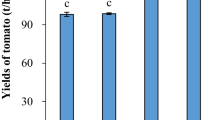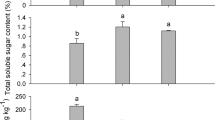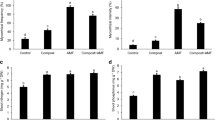Abstract
Purpose
Bio-organic–chemical fertilizer (BCF) has great potential to enhance agricultural production, protect environment, and improve sustainability. However, current BCFs are used only in a limited scope mainly due to the low activity of beneficial bacteria. It is significant to develop new BCFs with high beneficial bacteria activity for sustainable agricultural production.
Materials and methods
In this study, a novel slow-release bio-organic–chemical fertilizer (SBCF) was prepared from activated lignite, bacillus AMCC100153 (B153) (beneficial bacteria for tomato), and slow-release fertilizer (CSF) with suitable pH and low dissolubility salt content (to protect the bacterial activity). The pH and EC of different types of SBCFs with different compositions were determined and compared with those of BCFs derived from common chemical fertilizers (BCCF). The B153 activities were measured and compared with the optimum formula of SBCF. The bacillus colonization rules of SBCF and BCCF in tomato pot soil were explored by the Real-time qPCR.
Results and discussion
SBCF had higher bacillus activity than the corresponding BCCF. Pot experiments also showed that the bacillus formed colonization rapidly on tomato roots and secreted substances to promote root growth. The HPLC analysis found that the promoting substances were auxin and zeatin. Compared with no fertilizer control (CK) and the BCCF treatments, the SBCF treatment increased tomato yields by 73.08% and 29.04%, respectively.
Conclusions
Findings of this work suggest that SBCF with high biological activity and growth promoting effect has great potential in agriculture production system in the future.








Similar content being viewed by others
Date availability
The authors declare the date include in manuscript was available.
References
Alawi MA, Khalill F, Sahili I (1994) Determination of trihalomethanes produced through the chlorination of water as a function of its humic acid content. Arch Environ Contam Toxicol 26:381–386
Amossé J, Bettarel Y, Bouvier C, Bouvier T, Duc TT, Thu TD, Jouquet P (2013) The flows of nitrogen, bacteria and viruses from the soil to water compartments are influenced by earthworm activity and organic fertilization (compost vs. vermicompost). Soil Biol Biochem 66:197–203
Bhardwaj D, Ansari MW, Sahoo RK, Tuteja N (2014) Biofertilizers function as key player in sustainable agriculture by improving soil fertility, plant tolerance and crop productivity. Microb Cell Factories 13:66–75
Bravo-Martín-Consuegra S, García-Navarro FJ, Pérez-De-Los-Reyes C, Higueras PL (2016) Effect of the addition of sewage sludge as a fertilizer on a sandy vineyard soil. J Soils Sediments 16:1360–1365
Cai F, Pang G, Li RX, Li R, Gu XL, Shen QR, Chen W (2017) Bioorganic fertilizer maintains a more stable soil microbiome than chemical fertilizer for monocropping. Biol Fertil Soils 53:861–872
Cavagnaro TR (2014) Impacts of compost application on the formation and functioning of arbuscular mycorrhizas. Soil Biol Biochem 78:38–44
Chang E, Chung R, Tsai Y (2007) Effect of different application rates of organic fertilizer on soil enzyme activity and microbial population. J Soil Sci Plant Nutr 53:132–140
Chen S, Zhang M, Wang J, Lv D, Ma Y, Zhou B, Wang B (2017) Biocontrol effects of brevibacillus laterosporus AMCC100017 on potato common scab and its impact on rhizosphere bacterial communities. J Biol Control 106:89–98
Coban H, Miltner A, Elling FJ, Hinrichs KU, Kästner M (2015) The contribution of biogas residues to soil organic matter formation and CO2 emissions in an arable soil. Soil Biol Biochem 86:108–115
Dong X, Guan T, Li G, Lin Q, Zhao X (2016) Long-term effects of biochar amount on the content and composition of organic matter in soil aggregates under field conditions. J Soils Sediments 16:1481–1497
Fu L, Penton CR, Ruan Y, Shen Z, Xue C, Li R, Shen Q (2017) Inducing the rhizosphere microbiome by biofertilizer application to suppress banana fusarium wilt disease. Soil Biol Biochem 104:39–48
Glaser B, Wiedner K, Seelig S, Schmidt HP, Gerber H (2015) Biochar organic fertilizers from natural resources as substitute for mineral fertilizers. Agron Sustain Dev 35:667–678
Lescheva M, Ivolga A (2015) Intensification of agricultural production vs. environmental management: Russia's approaches to green economics. Plant Physiol 142:890–900
Liu E, Yan C, Mei X, He W, Bing SH, Ding L, Qin L, Shuang L, Fan T (2010) Long-term effect of chemical fertilizer, straw, and manure on soil chemical and biological properties in Northwest China. Geoderma 158:173–180
Lu C, Tian H (2017) Global nitrogen and phosphorus fertilizer use for agriculture production in the past half century: shifted hot spots and nutrient imbalance. Earth Syst Sci Data 9:181–192
Murase J, Hida A, Ogawa K, Nonoyama T, Yoshikawa N, Imai K (2015) Impact of long-term fertilizer treatment on the microeukaryotic community structure of a rice field soil. Soil Biol Biochem 80:237–243
Naz MY, Sulaiman SA (2016) Slow release coating remedy for nitrogen loss from conventional urea: a review. J Control Release 225:109–120
Nelissen V, Saha BK, Ruysschaert G, Boeckx P (2014) Effect of different biochar and fertilizer types on N2O and NO emissions. Soil Biol Biochem 70:244–255
Piotrowska-Dlugosz A, Breza-Boruta B, Dlugosz J (2019) Spatio-temporal heterogeneity of soil microbial properties in a conventionally managed arable field. J Soils Sediments 19:345–355
Shen Z, Ruan Y, Chao X, Zhang J, Li R, Shen Q (2015) Rhizosphere microbial community manipulated by 2 years of consecutive biofertilizer application associated with banana fusarium wilt disease suppression. Biol Fertil Soils 51:1–10
Shen Z, Xue C, Taylor P, Ou Y, Wang B, Zhao Y, RuanY LY, Shen Q (2018) Soil pre-fumigation could effectively improve the disease suppressiveness of biofertilizer to banana Fusarium wilt disease by reshaping the soil microbiome. Biol Fertil Soils 54:793–806
Shi Y, Liu X, Zhang Q, Gao P, Ren J (2019) Biochar and organic fertilizer changed the ammonia-oxidizing bacteria and archaea community structure of saline-alkali soil in the North China plain. J Soils Sediments 20:12–23
Spohn M, Kuzyakov Y (2013) Phosphorus mineralization can be driven by microbial need for carbon. Soil Biol Biochem 61:69–75
Tang Y, Yang Y, Cheng D, Gao B, Wan Y, Li YC (2017) Value-added humic acid derived from lignite using novel solid-phase activation process with Pd/CeO2 nanocatalyst: a physiochemical study. ACS Sustain Chem Eng 5:10099–10110
Traina SJ, Novak J, Smeck NE (1990) An ultraviolet absorbance method of estimating the percent aromatic carbon content of humic acids. J Environ Qual 19:151–153
Uddling J, Gelang-Alfredsson J, Piikki K, Pleijel H (2007) Evaluating the relationship between leaf chlorophyll concentration and SPAD-502 chlorophyll meter readings. Photosynth Res 91:37–46
Vetter SH, Sapkota TB, Hillier J, Stirling CM, Macdiarmid JI, Aleksandrowicz L, Green R, Joy EJ, Dangour AD, Smith P (2017) Greenhouse gas emissions from agricultural food production to supply indian diets: implications for climate change mitigation. Agric Ecosyst Environ 237:234–241
Xie J, Yang Y, Gao B, Wan Y, Li YC, Xu J, Zhao Q (2017) Biomimetic superhydrophobic biobased polyurethane-coated fertilizer with atmosphere "outerwear". ACS Appl Mater Interfaces 9:15868–15879
Xu Y, Zhang J, Shao J, Feng H, Shen Q (2020) Extracellular proteins of trichoderma guizhouense elicit an immune response in maize (zea mays) plants. Plant Soil:1–17
Yang Y, Zhang M, Li Y, Fan XH, Geng YQ (2012) Improving the quality of polymer-coated urea with recycled plastic, proper additives, and large tablets. J Agric Food Chem 60:11229–11237
Yang Y, Syed S, Mao S, Li Q, Lu C (2020) Bioorganic–mineral fertilizer can remediate chemical fertilizer-oversupplied soil: Purslane planting as an example. J Soil Sci Plant Nutr:1–9
Zahn D (2004) On the role of water in amide hydrolysis. Eur J Org Chem 2004:4020–4023
Zhang H, Ding W, Yu H, He X (2015) Linking organic carbon accumulation to microbial community dynamics in a sandy loam soil: result of 20 years compost and inorganic fertilizers repeated application experiment. Biol Fertil Soils 51:137–150
Zhang F, Huo Y, Xu X, Hu J, Sun X, Xiao Y, Zhang Y (2018) Trichoderma improves the growth of leymus chinensis. Biol Fertil Soils 54:685–696
Zhao J, Ni T, Li J, Lu Q, Fang Z, Huang Q, Zhang R, Li R, Shen B, Shen Q (2016a) Effects of organic–inorganic compound fertilizer with reduced chemical fertilizer application on crop yields, soil biological activity and bacterial community structure in a rice-wheat cropping system. Appl Soil Ecol 99:1–12
Zhao S, Chen X, Deng S, Dong X, Song A, Yao J, Fang W, Chen F (2016b) The effects of fungicide, soil fumigant, bio-organic fertilizer and their combined application on chrysanthemum fusarium wilt controlling, soil enzyme activities and microbial properties. Molecules 21:526–540
Funding
This research was funded by Taishan industrial experts program (LJNY201609), Shandong Province Key R&D Program (2017CXGC0306), Shandong agricultural innovation team (SDAIT-17-04), the Great innovation projects in agriculture of Shandong Province (Grant No. [2013] 136), and the National Key Research and Development Program of China (2016YFD0201105).
Author information
Authors and Affiliations
Corresponding author
Additional information
Editorial Responsibility: Jianming Xue
Publisher’s note
Springer Nature remains neutral with regard to jurisdictional claims in published maps and institutional affiliations.
Electronic supplementary material
ESM 1
(DOC 282 kb)
Rights and permissions
About this article
Cite this article
Wang, X., Yang, Y., Gao, B. et al. Slow-released bio-organic–chemical fertilizer improved tomato growth: synthesis and pot evaluations. J Soils Sediments 21, 319–327 (2021). https://doi.org/10.1007/s11368-020-02775-0
Received:
Accepted:
Published:
Issue Date:
DOI: https://doi.org/10.1007/s11368-020-02775-0




